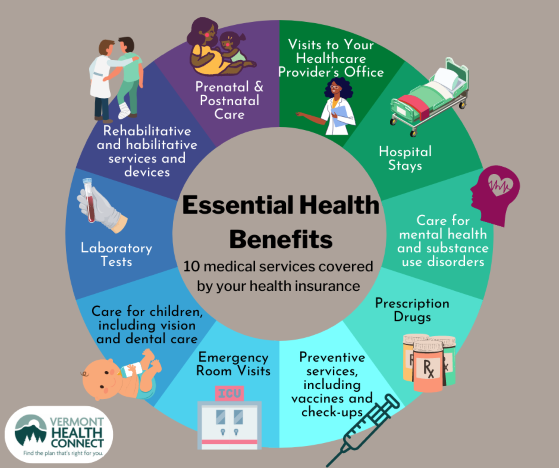The 10-Minute Rule for Medicare Advantage Agent
Table of ContentsHow Medicare Advantage Agent can Save You Time, Stress, and Money.Medicare Advantage Agent - TruthsAll About Medicare Advantage Agent

follows from confusing the perplexing young age profile of account uninsured with the better healthFar better wellness average, of younger persons. For those without access to workplace health and wellness insurance policy, bad wellness is a potential obstacle to purchasing nongroup protection since such insurance coverage might be highly priced, omit preexisting problems, or be just inaccessible. Unless or else kept in mind, nationwide estimates of individuals without health insurance and proportions of the population with different kinds of coverage are based on the CPS, the most commonly made use of resource of quotes of insurance protection and uninsurance rates.

Little Known Facts About Medicare Advantage Agent.
Over a three-year duration starting early in 1993, 72 million individuals, 29 percent of the U.S. population, were without coverage for a minimum of one month. Within a solitary year(1994), 53 million individuals experienced at the very least a month without insurance coverage(Bennefield, 1998a). Six out of every 10 uninsured grownups are themselves employed. Although working does enhance the likelihood that and one's household participants will have insurance policy, it is not a warranty. Even participants of family members with 2 full time breadwinner have nearly a one-in-ten chance of being uninsured (9.1 percent without insurance price)(Hoffman and Pohl, 2000 ). The partnership between medical insurance and access to care is well established, as recorded later on in this chapter. The relationship between wellness insurance coverage and health end results is neither direct neither basic, an extensive scientific and health and wellness solutions research study literature links health and wellness insurance policy protection
to improved better accessibility care, better far betterTop quality and improved personal and population health health and wellness. For instance, the second report, on individual health and wellness results for uninsured grownups, is represented by the innermost circle of the figure, while the 3rd record, on family members wellness, encompasses the topics of the second report but highlights a various unit of evaluation, specifically, the household. The 6th report in the series will present details concerning methods and campaigns carried out in your area, statewide, or across the country to deal with the absence of insurance and its unfavorable impacts. Levels of analysis for taking a look at the results of uninsurance. This conversation of wellness insurance policy coverage concentrates primarily on the united state population under age 65 due to the fact that essentially all Americans 65 and older have Medicare or various other public protection.
Furthermore, it concentrates especially on those without any kind of medical insurance for any type of size of time. The issues dealt with by the underinsured remain in some respects similar to those dealt with by the without insurance, although they are typically less serious. Uninsurance and underinsurance, nonetheless, include clearly various plan problems, and the approaches for resolving them might differ. Throughout this research study and the five records to comply with, the main emphasis gets on individuals with no health and wellness insurance policy and hence no help in paying for health and wellness care beyond what is offered with charity and security net establishments. Medical insurance is an effective aspect influencing receipt of care because both individuals and doctors react to the out-of-pocket price of services. Medical insurance, nonetheless, is neither needed neither sufficient to access to clinical solutions. look at here now Nevertheless, the independent and direct impact of health and wellness
insurance protection on accessibility to health and wellness services is well developed. Others will certainly get the healthcare they require also without wellness insurance coverage, by paying for it out of pocket or seeking it from companies who use care cost-free or at extremely subsidized prices. For still others, medical insurance alone does not guarantee receipt of treatment because of various other nonfinancial barriers, such as an absence of healthcare companies in their community, minimal access to transportation, illiteracy, or etymological and cultural distinctions. Formal research study about without insurance populations in the United States dates to the late 1920s and very early 1930s when the Committee on the Expense of Medical Treatment produced a collection of reports regarding funding doctor workplace check outs and hospitalizations. This problem became prominent as the varieties of clinically indigent climbed throughout the Great Clinical depression. Empirical studies constantly sustain the link between access to care and improved wellness results(Bindman et al., 1995; Starfield, 1995 ). Having a routine source of treatment can be thought about a predictor of accessibility, instead of a direct step of it, when wellness outcomes are themselves used as gain access to indications. This extension of the concept of gain access to measurement was made by the IOM Board on Monitoring Access to Personal Healthcare Solutions(Millman, 1993, p. Whether parents are guaranteed shows up to influence whether their youngsters receive care as well as how much careeven if the children themselves have coverage(Hanson, 1998). The health of moms and dads can affect their capacity to take care of their kids and the level of household anxiety. Fretting about their kids's access to care is itself a source of stress and anxiety for parents. Three phases follow in this record. Phase 2 gives an introduction of how employment-based medical insurance, public programs and private insurance plans operate and interact to provide extensive yet incomplete protection of the U.S. populace. This consists of a testimonial content of historic trends and public laws influencing both public and private insurance policy, a discussion of the communications amongst the different types of insurance coverage, and an assessment of why people relocate from one program to one more or finish up
